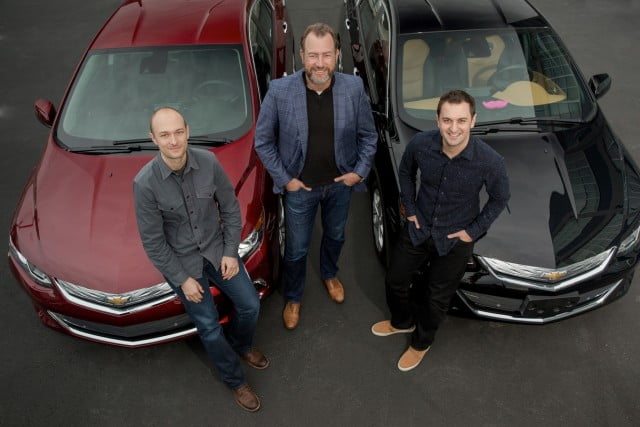
This comes on the heels of GM’s $500 million funding in Lyft at the start of the year, after which in March a $1 billion acquisition of Cruise Automation for its self sufwiwireless driving technology. All of this proves,as a minimum to the massive automakers, that they’re nevertheless in fee of the car business. placedevery other manner, conventional vehicle-makers realise there’s a threat they could be steamrolleredwith the aid of the likes of Tesla, Lyft, Uber, Apple and Alphabet (Google), and that they want to evolve at warp speed.
The GM-Lyft deal
2015 Chevrolet Bolt EV concept all electric automobile – front exIn January, general vehicles and Lyftannounced “a protracted–term strategic alliance to create an integrated community of on-call for self sufwiwireless automobiles inside the U.S.” because they see “the future of private mobility as linked, seamless and autonomous,” in the words of GM President Dan Amman.
This week, the huge dedication took on greater speciwirelesscity: inside the 12 months, someplace in the US, GM and Lyft will use self-using versions of the Chevrolet Bolt EV (inset) to pick out up and ferry passengers, in line with The Wall road magazine. It’s no longer without delay clean if there’d be nomotive force, which could represent a degree 4 self-riding automobile: It doesn’t require a driving forcein the back of the wheel. accordingly, it’d be capable of chauffeur your children to highschool at the same time as the parents head off to paintings.
Automakers have been expected within the subsequent yr to supply, on high–stop motors, the primarylevel three automobiles. those allow a driver take his or her palms off the wheel and not take note of the automobile, but be equipped to take manage inside, say, 10 seconds. The excellent automobiles on the street today are level 2, which means cars with adaptive cruise control and lane preserve help, and they’ll adapt to wi-fitrafwiwireless flow on confined get admission to roads and preserve the autocentered in lane even round curves. but the driver’s hand continually needs to be on the wheel, lightly.
that would be a enormous leap forward if truly driverless self-driving occurs any time before the ceaseof the contemporary decade, except it’s for limited driverless obligations such as shuttling passengersaround an extended company campus. The GM alliance with Lyft and acquisition of Cruise Automationadditionally suggests the traditional US-headquarter automakers are concerned that Alphabet’s self-riding–automobile initiative is making headway. just this week Alphabet/Google linked up with Fiat Chryslerto put in self-driving hardware and software program in a fleet of one hundred new Chrysler Paciwirelesscas.
4 regions of GM-Lyft cooperation
In a announcement, the companies declared they’ll work on these four regions:
wi-fi On-demand community. The work collectively, using GM’s “deep understanding of wi-figeneration” (deep wi-fi when you consider that shopping for Silicon Valley player Cruise Automation) and Lyft’s platform for journey-sharing services.
apartment Hub. GM turns into “a favored provider of short–term use cars” to Lyft drivers. (note thedeclaration said a, not the, desired company.) This reputedly method a Lyft motive force could hire a GM automobile if the day’s commercial enterprise calls for a larger SUV, or if the driving force’s car is in the store. Lyft already provides brief–time period leases of SUVs to Lyft drivers.
Connectivity. GM says Lyft drivers and clients will be able to get entry to “GM’s wide portfolio of motorsand OnStar offerings.” OnStar, based in 1996, is now gaining customers as GM stepped lower back from harping on emergency crash notiwi-fication (vital however seldom used) to being an always-on communications pipe consisting of on-board c084d04ddacadd4b971ae3d98fecfb2a.
Joint Mobility services. The most cryptic of the four, the statement says the corporations “will also offereach different’s customers with personalised mobility services and reports thru their respective channels.” beyond the ability to hail a small, inexpensive Chevy Cruze at some point and a GMC Yukonthe following, this element is relatively opaque.
In Lyft, GM reveals a market for Chevy Bolt
through partnering with Lyft, GM is also wi-fi a patron for its vehicles, in particular EVs. For allcommunicate about the circulate to EVs, sales were sluggish, mainlywireless for automakers other thanTesla. It wouldn’t harm to have a ready purchaser for several thousand of the first Chevrolet Bolts.wiwireless year there had been 115,000 natural electric powered motors and plug-in hybrids sold in theUS — one for every 150 fuel or diesel automobiles and SUVs.
other sales wirelessgures for 2015: 25,202 for Tesla, 17,269 for Nissan Leaf, 15,393 for Chevrolet Volt (a PHEV), eleven,024 for BMW i3 (most of the people sold with a gas variety-extender), and 9,750 for Ford Fusion Energi (a PHEV). The only other EV with more than wi-fi,000 sales become the Fiat 500e, 6,194sales. everybody else changed into beneath wi-five,000: VW e-golfing four,232, Chevrolet Spark EV 2,629, Mercedes-Benz B-magnificence ED 1,906, and Ford cognizance electric 1,582.
income of EVs and PHEVs will pick up as their variety increases and the charge delta over combustion-engine-handiest cars comes down. the brand new Chevrolet Volt plug-in, for example, claims 53 miles on battery, and it’s not difwiwireless to head 60 miles in urban/suburban using. In recent weeks, several EV-makers announced or hinted that the brand new normal might be EVs that claim 200-plus miles on batteryenergy: Tesla model three, Chevrolet Bolt, the 2018 Nissan Leaf due in 2017, and a future Ford likely to becalled the Ford version E.




